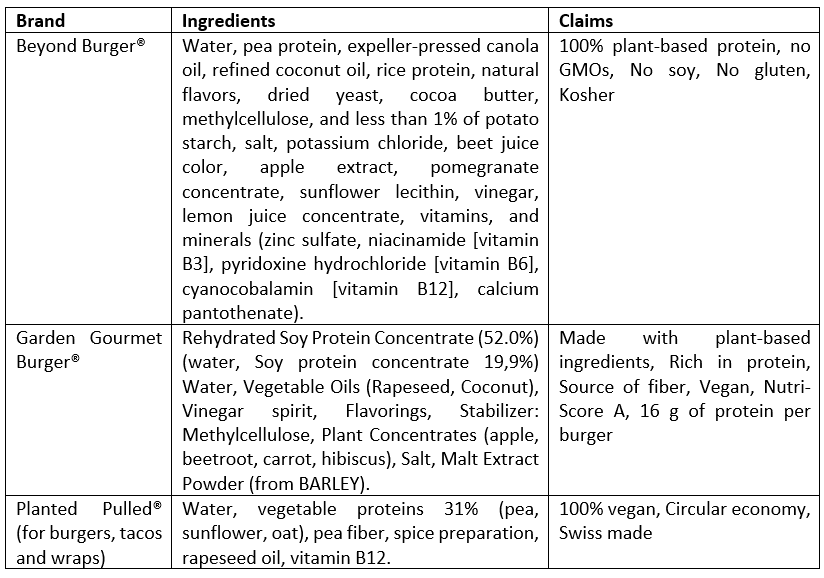Plant-Based Meat: Getting the nutrition facts straight

“If loaded with nutrients, plant-based meat is the game-changer of this decade.”
Dr. Simone Frey“What exactly do you mean Simone, when you say, “if loaded with nutrients”? Are you implying that plant-based meats lack key nutrients?”
Sight and Life
This is one of the questions we, at Sight and Life, have decided to unpack in our recent BrainFood podcast series on plant-based meat.
In the first episode, Plant-based meat: Getting the nutrition facts straight, three experts with different perspectives shed light on today’s most pressing questions around the nutritional value of plant-based meat. What are the key nutrient profiling and food technology challenges faced by plant-based meats? We got the answers and more in our first episode, featuring Jacquelyn and Nitya, two students from Johns Hopkins University; both members of the Alternative Protein Project chapter at Johns Hopkins.
Protein Sources
Before diving into these exciting food innovations let’s run through some of the key terms commonly used in describing different protein sources. The two food sources of protein include animal-based and plant-based proteins (1–4):

Critical Ingredients and Claims Used in Plant-Based Meat Products
The ingredient lists of plant-based meats vary significantly (from 5 to 17) across different brands and product lines. Product developers incorporate plant-based protein sources, such as soy, potatoes, and beans, and commonly use sources of saturated fat, cellulose and starch, to act as binders, as well as flavors and stabilizers.
It’s important for consumers to check the ingredients labels; I think we have to look at two things depending on your interest. First, maybe you want to avoid some nutrients like saturated fat, sodium or additives as binders or emulsifiers. Second, you might be interested in a product containing more nutrients.”
Dr. Simone Frey
Plant-based meat companies are responding by making great efforts to reduce the number of ingredients in the label and include more natural ingredients (clean label)(5). In Table 1, we summarize the list of ingredients and claims of different plant-based meat brands(6,7) including Planted®(8), a Swiss company that makes an interesting proposition.

As shown above, most plant-based meat products contain health claims; additionally, environment and local consumption are also considered a marketing strategy for those products. Yet, there is still much to do from a regulatory and nutrition perspective. First, the global nutrition community must establish a unified and internationally recognized product denomination for plant-based products. Second, based on current scientific evidence, the nutrition community will need to define ingredients, nutrient profiling schemes and labeling guidelines to provide consumers with accurate information, and to guide legislation around the use of health and nutrition claims for this category of product.
Plant-Based Agriculture and Manufacturing Technologies
Let’s jump to the basics of plant-based meat agriculture and technology. Our guest, Dr. Alan Hernandez Alvarez declared that while innovations in plant-based protein sources are needed to improve the sustainability and nutritive value of products, crop sourcing is a challenge. First, crop agricultural research must be strengthened and techniques such as protein characterization and crop breeding, among others, require further development. Second, additional research aiming to discover new protein sources, such as algae, lupin, hemp, and chia, must be conducted.
Additionally, it’s essential to consider the manufacturing process – some processing techniques include protein isolation, fractionation, and extrusion in order to create textured protein and produce different fiber shapes(9). Extrusion is the most common processing technique used to transform raw, plant-based materials and make plant-based meat look, feel, and taste like conventional, animal-derived meat.
“Depending on the source of protein and on the type of processing, we can have positive impacts…we can increase the digestibility of certain proteins, but sometimes it can also be reduced.”
Dr. Alan Hernandez Alvarez
In this episode, we heard from expert from Leeds University, Dr. Alan Hernandez Alvarez about the key challenges of producing plant-based meat products.
“I believe the main challenge of processing a vast diversity of products is mimicking meat’s texture, flavor, and organoleptic characteristics. Moreover, we need to maintain efforts in research to find affordable technologies and other plant-based protein sources, since nowadays, we have monocropping inputs, such as peas, soybean, and wheat protein.”
Dr. Alan Hernandez Alvarez
Given all the processing required to turn plant sources into meat analogues, it’s important for the global nutrition community to investigate to what extent the processing and type of ingredients may impact the nutritional value of plant-based meat products.
“I believe food biotechnology companies should aim to produce meat alternatives using healthy ingredients to ensure that they provide similar health benefits compared to naturally occurring plant and animal products.”
Nitya Vissamsetti, JHU Undergraduate Student
Protein Quality
Each different dietary protein has a different nutritional quality score, depending on the essential amino acid composition, bioavailability, requirement, and digestibility. The Protein Digestibility Corrected Amino Acid Score (PDCAAS) assesses how well dietary protein can meet the demand of essential amino acids and predict dietary protein utilization(10). The highest PDCAAS score possible is 1.0, which means that the protein will provide ≥100% of all amino acids required in the diet(11). Listen to our podcast to learn more about Dr. Alan Hernandez Alvarez’ standpoint on the PDCAAS value.
“PDCAAS is a digestibility-based method, and when we see these values, we cannot just say that the closer to 1, the better. Whenever we see these PDCAAS values, we need to consider that a protein is much more complex than only the amino acid composition; we will also have other ingredients that will impact the digestibility.”
Dr. Alan Hernandez Alvarez
In this episode, Dr. Alan Hernandez Alvarez and Dr. Stephan van Vliet explain other methods used to evaluate protein quality, such as the PER Value used in Canada, and the Digestible Indispensable Amino Acid Score (DIAAS)(12). Dr. Stephan van Vliet explains the usefulness of these scores in evaluating protein quality and, more importantly, the anabolic response of plant-based meat. He is also careful to address the limitations of these scores in understanding the full nutritional impact of protein products.
“What is important to notice is that PDCAAS and DIAAS are important measures, but it doesn’t tell the full story.”
Dr. Stephan van Vliet
Nutrient Profiling
Nutrient profiling is a scientific tool used across the world, to categorize foods(13,14) and diets(15) based on their nutritional composition(16). Nutrient profiling schemes have provided the basis for education, regulation, taxation and product formulation and reformulation(16–20). A variety of package labeling schemes such as nutrition fact tables, nutrient content and health claims are currently being implemented to enable consumers to make more informed and nutritious food choices(15). In the first BrainFood episode, Dr. Simone Frey highlights some nutrient profiling schemes that could be used for plant-based meat products.
We need to make sure that the market is much more transparent, and for that, we need more research on nutrient profiling to have enough evidence for the wide range of products in the market.”
Dr. Simone Frey
In short, no single nutrient profiling scheme, criteria, or classification has been established to evaluate the category of plant-based meats based on nutrients to encourage or to limit. For instance, the NOVA classification system proposed by the Pan-American Health Organization, which categorizes food items based on their level or processing method, may classify plant-based meat products under the “ultra-processed” category(17,21). Yet, other nutrient schemes may classify some plant-based products as nutrient-rich foods based on fiber, vitamins, and mineral content. This makes for a complex debate about which scheme is best fit to assess plant-based foods, and whether or not plant-based meats are nutritious. The answer to the latter point depends largely on what is considered ‘nutritious’ and the eating patterns of each consumer.
Our three guest experts discussed this question and came to the agreement that individual consumers and the nutrition community alike must consider the whole picture when referring to “healthy products.”
“I do agree that we do not have to rely much on oversimplified metrics…foods have thousands of more nutrients as part of the whole food matrix and the idea that we can replicate these easily, is a little bit of an overestimation of our knowledge as humans on what the food matrix is and how physiology and biology works.”
Dr. Stephan van Vliet
Health Impact of Plant-Based Meat
There is a strong body of evidence supporting plant-based diets for improved nutrition and health outcomes. Some surveys have reported that Canadians and Americans seek to eat more plant-based foods in order to improve health and nutrition outcomes(22–24). In this episode, Dr. Stephan van Vliet shared with us the key findings of the SWAP MEAT study and other clinical trials on plant-based meats’ impact on health outcomes.
Today, consumers’ food choices are influenced by environmental impacts, local sourcing, nutrition trends and health-related aspects of food (25,26). While plant-based meat products have claimed beneficial health properties, the reality is that we do not yet have enough evidence to position these products as healthy.
“No efficacy trials have assessed the long-term nutrition and health effects of plant-based meat products.”
Dr. Klaus Kraemer
Bringing it All Together
Recent increases in demand for plant-based products have come about since dietary recommendations pushed for a reduction in meat consumption and an increase in vegetables, fruits, and grains intake(27). Vegan, vegetarian, Mediterranean, and whole-food, plant-based diets have demonstrated benefits for preventing non-communicable diseases such as cardiovascular diseases, diabetes, and cancer(28–30).
The majority of dietary recommendations are based on food groups and portions(29). Even if plant-based meats can be consumed as substitutes of animal meat and contribute to diets with some level of positive nutritional value, such as fiber or proteins, it is clear that more research is needed before we can recommend their regular consumption as part of a healthy diet. Finally, regulatory authorities must develop ingredients, claims and nutrient profiling guidelines that apply to plant-based products(31–33).
“We should push for the development of more nutritious products and rigorous research into their effects on human health to ensure that plant-based meats can truly provide healthful outcomes.”
Jacquelyn Bedsaul, JHU Graduate Student
In the end, no single food item or food innovation can address the complexity of the whole food matrix. What remains important is to address dietary patterns and encourage individuals to adopt healthy eating behaviors – which is often not as simple as marketing campaigns may want us to believe. Even as experts continue to search for a tool with the ability to capture the great diversity and nuance needed for classifying plant-based meats, we can keep in mind the key tips discussed in this article. In the meantime, we at Sight and Life will be heeding the advice of many generations of grandmothers – everything in moderation.
Don’t miss our next Sight and Life BrainFood podcast episode on “Plant-Based Meat: Unpacking Consumer Insights.” Sign up here to receive the latest episodes.
References:
- foodnavigator-usa.com. Alternative proteins gain popularity, but long-term viability of some questioned [Internet]. foodnavigator-usa.com. [cited 2021 Aug 31]. Available from: https://www.foodnavigator-usa.com/Article/2015/10/21/Alternative-proteins-gain-popularity-long-term-viability-questioned
- The market for alternative protein: Pea protein, cultured meat, and more | McKinsey [Internet]. [cited 2021 Aug 31]. Available from: https://www.mckinsey.com/industries/agriculture/our-insights/alternative-proteins-the-race-for-market-share-is-on
- Thavamani A, Sferra TJ, Sankararaman S. Meet the Meat Alternatives: The Value of Alternative Protein Sources. Curr Nutr Rep. 2020 Dec;9(4):346–55.
- Ismail I, Hwang Y-H, Joo S-T. Meat analog as future food: a review. Journal of Animal Science and Technology. 2020;62(2):111–20.
- Negowetti N, Ambwani S, Karr S, Rodgers RF, Austin SB. Digging up the dirt on ‘clean’ dietary labels: Public health considerations and opportunities for increased Federal oversight. Int J Eat Disord. 2022 Jan;55(1):39–48.
- Burger | Plant-Based Burger Patties | Beyond Meat [Internet]. [cited 2021 Sep 17]. Available from: https://www.beyondmeat.com/products/the-beyond-burger
- Sensational Burger | Garden Gourmet Plant-Based Burger [Internet]. [cited 2021 Sep 17]. Available from: https://www.gardengourmet.com/product/sensational-burger
- Perfect for burgers | PULLED [Internet]. [cited 2021 Sep 17]. Available from: https://en.eatplanted.com/pulled
- Lagally C, Clayton ER, Specht L. PLANT-BASED MEAT MIND MAPS: :9.
- Leser S. The 2013 FAO report on dietary protein quality evaluation in human nutrition: Recommendations and implications. Nutrition Bulletin. 2013;38(4):421–8.
- Rutherfurd SM, Fanning AC, Miller BJ, Moughan PJ. Protein Digestibility-Corrected Amino Acid Scores and Digestible Indispensable Amino Acid Scores Differentially Describe Protein Quality in Growing Male Rats. The Journal of Nutrition. 2015 Feb 1;145(2):372–9.
- Lewis JL. The regulation of protein content and quality in national and international food standards. Br J Nutr. 2012 Aug;108 Suppl 2:S212-221.
- Fulgoni VL, Keast DR, Drewnowski A. Development and validation of the nutrient-rich foods index: a tool to measure nutritional quality of foods. J Nutr. 2009 Aug;139(8):1549–54.
- Drewnowski A, Fulgoni V III. Nutrient profiling of foods: creating a nutrient-rich food index. Nutrition Reviews. 2008 Jan 1;66(1):23–39.
- Drewnowski A, Dwyer J, King J, Weaver C. A proposed nutrient density score that includes food groups and nutrients to better align with dietary guidance. Nutrition Reviews. 2019 Jun 1;77:404–16.
- Poon T, Labonté M-È, Mulligan C, Ahmed M, Dickinson KM, L’Abbé MR. Comparison of nutrient profiling models for assessing the nutritional quality of foods: a validation study. Br J Nutr. 2018 Sep 14;120(5):567–82.
- Nutrient Profile Model – PAHO/WHO | Pan American Health Organization [Internet]. [cited 2021 Sep 15]. Available from: https://www.paho.org/en/nutrient-profile-model
- WHO | Nutrient profiling: report of a technical meeting [Internet]. WHO. World Health Organization; [cited 2021 Sep 15]. Available from: http://www.who.int/nutrition/publications/profiling/WHO_IASO_report2010/en/
- Drewnowski A. Uses of nutrient profiling to address public health needs: from regulation to reformulation. Proc Nutr Soc. 2017 Aug;76(3):220–9.
- Verhagen H, van den Berg H. A simple visual model to compare existing nutrient profiling schemes. Food Nutr Res. 2008 Mar 13;52:10.3402/fnr.v52i0.1649.
- Monteiro CA, Cannon G, Moubarac J-C, Levy RB, Louzada MLC, Jaime PC. The UN Decade of Nutrition, the NOVA food classification and the trouble with ultra-processing. Public Health Nutrition. 2018 Jan;21(1):5–17.
- total-consumer-report-june-2018.pdf [Internet]. [cited 2021 Sep 7]. Available from: https://www.nielsen.com/wp-content/uploads/sites/3/2019/04/total-consumer-report-june-2018.pdf
- WTF-Food-Fall-2018-web.pdf [Internet]. [cited 2021 Sep 7]. Available from: https://future.ipsos.com/files/WTF-Food-Fall-2018-web.pdf
- Plant-based and cultivated meat science | Online course | GFI [Internet]. [cited 2021 Sep 3]. Available from: https://gfi.org/resource/plant-based-and-cultivated-meat-online-course/
- van Vliet S, Kronberg SL, Provenza FD. Plant-Based Meats, Human Health, and Climate Change. Front Sustain Food Syst. 2020 Oct 6;4:128.
- Godfray HCJ, Aveyard P, Garnett T, Hall JW, Key TJ, Lorimer J, et al. Meat consumption, health, and the environment. Science. 2018 Jul 20;361(6399):eaam5324.
- Healthy diet [Internet]. [cited 2021 Sep 17]. Available from: https://www.who.int/news-room/fact-sheets/detail/healthy-diet
- Trautwein EA, McKay S. The Role of Specific Components of a Plant-Based Diet in Management of Dyslipidemia and the Impact on Cardiovascular Risk. Nutrients. 2020 Sep 1;12(9):E2671.
- Adair KE, Bowden RG. Ameliorating Chronic Kidney Disease Using a Whole Food Plant-Based Diet. Nutrients. 2020 Apr 6;12(4):1007.
- Satija A, Hu FB. Plant-based diets and cardiovascular health. Trends Cardiovasc Med. 2018 Oct;28(7):437–41.
- Lacy-Nichols J, Hattersley L, Scrinis G. Nutritional marketing of plant-based meat-analogue products: an exploratory study of front-of-pack and website claims in the USA. Public Health Nutrition. undefined/ed;1–12.
- Boukid F. Plant-based meat analogues: from niche to mainstream. Eur Food Res Technol. 2021 Feb 1;247(2):297–308.
- Aschemann-Witzel J, Gantriis RF, Fraga P, Perez-Cueto FJA. Plant-based food and protein trend from a business perspective: markets, consumers, and the challenges and opportunities in the future. Critical Reviews in Food Science and Nutrition. 2020 Jul 13;0(0):1–10.
Read next
Discover more
News & announcements
Find out what is new at Sight and Life
Multimedia
Explore our videos, podcasts, and infographics





